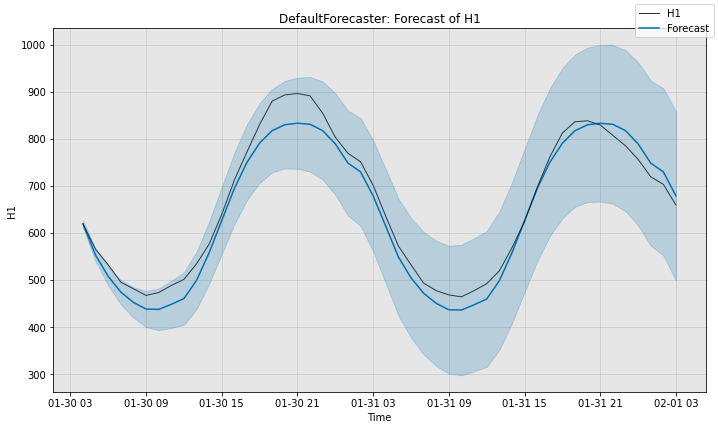A Gentle Introduction to Forecasting in Merlion
We begin by importing Merlion’s TimeSeries class and the data loader for the M4 dataset. We can then divide a specific time series from this dataset into training and testing splits.
[1]:
from merlion.utils import TimeSeries
from ts_datasets.forecast import M4
time_series, metadata = M4(subset="Hourly")[0]
train_data = TimeSeries.from_pd(time_series[metadata.trainval])
test_data = TimeSeries.from_pd(time_series[~metadata.trainval])
We can then initialize and train Merlion’s DefaultForecaster, which is an forecasting model that balances performance with efficiency. We also obtain its predictions on the test split.
[2]:
from merlion.models.defaults import DefaultForecasterConfig, DefaultForecaster
model = DefaultForecaster(DefaultForecasterConfig())
model.train(train_data=train_data)
test_pred, test_err = model.forecast(time_stamps=test_data.time_stamps)
Inferred granularity <Hour>
/Library/Frameworks/Python.framework/Versions/3.9/lib/python3.9/site-packages/statsmodels/base/model.py:604: ConvergenceWarning: Maximum Likelihood optimization failed to converge. Check mle_retvals
warnings.warn("Maximum Likelihood optimization failed to "
/Library/Frameworks/Python.framework/Versions/3.9/lib/python3.9/site-packages/statsmodels/base/model.py:604: ConvergenceWarning: Maximum Likelihood optimization failed to converge. Check mle_retvals
warnings.warn("Maximum Likelihood optimization failed to "
/Library/Frameworks/Python.framework/Versions/3.9/lib/python3.9/site-packages/statsmodels/base/model.py:604: ConvergenceWarning: Maximum Likelihood optimization failed to converge. Check mle_retvals
warnings.warn("Maximum Likelihood optimization failed to "
Next, we visualize the model’s predictions.
[3]:
import matplotlib.pyplot as plt
fig, ax = model.plot_forecast(time_series=test_data, plot_forecast_uncertainty=True)
plt.show()

Finally, we quantitatively evaluate the model. sMAPE measures the error of the prediction on a scale of 0 to 100 (lower is better), while MSIS evaluates the quality of the 95% confidence band on a scale of 0 to 100 (lower is better).
[4]:
from scipy.stats import norm
from merlion.evaluate.forecast import ForecastMetric
# Compute the sMAPE of the predictions (0 to 100, smaller is better)
smape = ForecastMetric.sMAPE.value(ground_truth=test_data, predict=test_pred)
# Compute the MSIS of the model's 95% confidence interval (0 to 100, smaller is better)
lb = TimeSeries.from_pd(test_pred.to_pd() + norm.ppf(0.025) * test_err.to_pd().values)
ub = TimeSeries.from_pd(test_pred.to_pd() + norm.ppf(0.975) * test_err.to_pd().values)
msis = ForecastMetric.MSIS.value(ground_truth=test_data, predict=test_pred,
insample=train_data, lb=lb, ub=ub)
print(f"sMAPE: {smape:.4f}, MSIS: {msis:.4f}")
sMAPE: 4.1944, MSIS: 18.9331